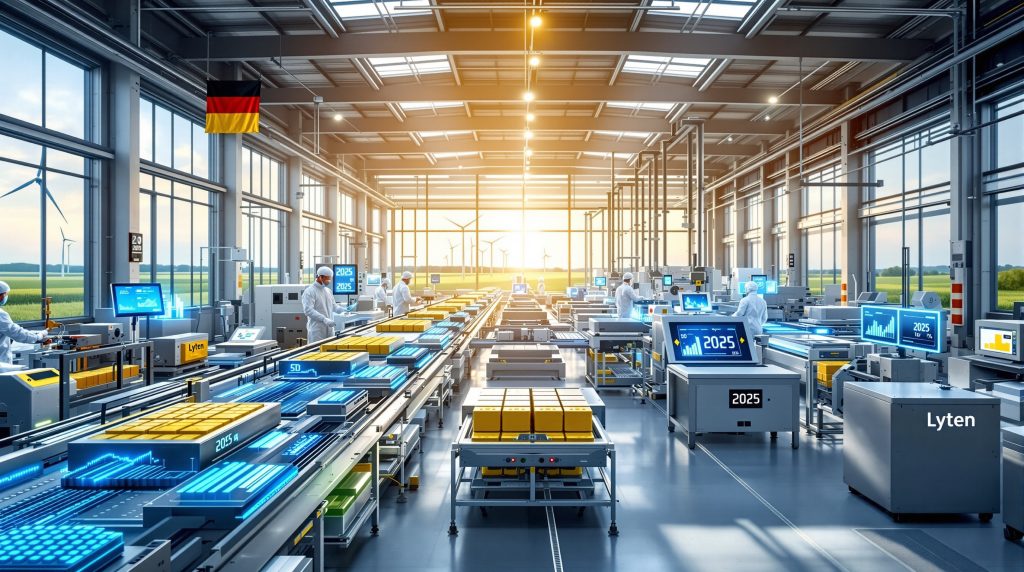Lyten's Battery Factory Plans in Heide: A New Chapter After Northvolt
What is Lyten's vision for the former Northvolt site in Heide?
Lyten, a California-based battery technology company, has unveiled its strategic plans for the battery cell manufacturing facility in Heide, Germany, following its acquisition of Northvolt's assets. CEO Dan Cook recently presented a comprehensive roadmap to the Schleswig-Holstein state government, outlining a more modest but technologically diverse approach compared to Northvolt's original vision.
The acquisition, announced in early August 2025, has already secured necessary approvals though the purchase process remains ongoing with confidential details according to official statements from Lyten.
While Northvolt had initially planned for a 15 GWh annual production capacity with approximately 3,000 direct jobs, Lyten's revised scope envisions creating around 1,000 positions at the facility. This represents a significant scaling back from the original plan, which had also projected an additional 6,000-7,000 indirect jobs at suppliers and service providers throughout the region.
Despite the reduction in scale, Lyten aims to maintain the strategic importance of the Heide location while implementing a more phased and modular approach to manufacturing deployment.
The Transition from Northvolt to Lyten
The transition from Northvolt to Lyten marks a significant shift in strategy for the Heide facility. While Northvolt had envisioned a massive gigafactory focused exclusively on NMC (nickel-manganese-cobalt) lithium-ion technology, Lyten plans to diversify the technological approach.
According to statements from Cook at the meeting in Kiel with the Schleswig-Holstein government, the company plans to implement a hybrid manufacturing strategy that will incorporate both conventional lithium-ion technology and Lyten's proprietary next-generation battery chemistry.
The timeline for full operational restart is targeted for late 2025, pending final regulatory approvals and completion of the acquisition process. This staged implementation approach differs substantially from Northvolt's original all-at-once deployment plan.
How will Lyten's technology differ from Northvolt's original plans?
Innovative Dual-Chemistry Approach
One of the most significant technological differentiators in Lyten's plan for the Heide facility is its dual-chemistry manufacturing strategy. The company intends to produce both conventional lithium-ion batteries using NMC chemistry (originally developed by Northvolt) alongside its proprietary lithium-sulfur technology.
This hybrid approach provides several strategic advantages. The conventional NMC production can capitalize on existing market demand and manufacturing know-how, while the lithium-sulfur technology represents a potential leap forward in battery recycling breakthrough and sustainability.
Further distinguishing Lyten's approach is its emphasis on data-driven manufacturing. Cook highlighted an "intelligent, data-driven manufacturing strategy" that will optimize production efficiency and quality control through advanced analytics and real-time monitoring systems.
Technological Advantages of Lithium-Sulfur Batteries
Lithium-sulfur technology represents a potentially significant advancement over traditional lithium-ion batteries. The chemistry offers theoretical energy density up to 2-3 times greater than conventional lithium-ion batteries, which could enable longer-range electric vehicles and more efficient energy storage systems.
Another key advantage of lithium-sulfur technology is its reduced dependence on critical minerals like cobalt and nickel, which face supply constraints and ethical sourcing challenges. Sulfur is an abundant element and often a byproduct of other industrial processes, making it potentially more sustainable and cost-effective.
When scaled effectively, lithium-sulfur batteries may offer lower production costs compared to conventional lithium-ion cells. The materials are generally less expensive, and the manufacturing process could potentially be less energy-intensive.
From an environmental perspective, lithium-sulfur batteries present a more sustainable alternative with potentially lower carbon footprint and reduced use of rare earth elements and conflict minerals.
What economic impact will Lyten's factory have on the region?
Employment and Economic Outlook
While smaller than Northvolt's original vision, Lyten's plan to create approximately 1,000 direct jobs at the Heide facility still represents a significant economic opportunity for the Schleswig-Holstein region. As confirmed by SSW economic policy spokesperson Sybilla Nitsch following the economic committee meeting, this employment figure marks a 67% reduction from Northvolt's initial 3,000 job target.
Beyond direct employment, the factory is expected to generate additional positions in the supply chain and service sectors, though specific projections for indirect job creation have not been announced. The battery metals investment industry typically creates a substantial employment multiplier effect, with supply chain jobs often exceeding direct manufacturing positions.
Regarding workforce development, there may be opportunities for rehiring former Northvolt employees who were involved in the initial planning and early construction phases of the facility. This would help preserve specialized knowledge and skills within the regional workforce.
For Schleswig-Holstein's broader economy, the establishment of a next-generation battery manufacturing presence represents a significant boost, particularly in diversifying the industrial base beyond the region's traditional sectors.
Comparison with Original Northvolt Plans
| Aspect | Northvolt Original Plan | Lyten Revised Plan |
|---|---|---|
| Direct Jobs | 3,000 | 1,000 |
| Indirect Jobs | 6,000-7,000 | Not yet specified |
| Production Capacity | 15 GWh | To be determined |
| Technology | NMC lithium-ion | Hybrid: NMC + lithium-sulfur |
| Implementation | Single phase | Modular, phased approach |
While the job creation numbers are lower than initially hoped, the technological diversification and potentially higher value-added focus of Lyten's approach could create more sustainable economic benefits in the long term. The modular implementation strategy also allows for more adaptable growth based on market demand and technological maturation.
How will the Heide factory be financed?
Funding Strategy and Government Support
The financing structure for the Heide facility represents another significant departure from Northvolt's original plan. The German federal and state governments had originally pledged €700 million in funding for Northvolt's project, but as confirmed by multiple sources, this funding cannot simply be transferred to another company.
Lyten appears to be taking a different approach to financing the project, with a greater emphasis on private capital. Cook has highlighted the company's tradition of raising private funds and stated that it is important for private companies to use private funds for the majority of their development activities.
This philosophy aligns with comments from Schleswig-Holstein Economics Minister Claus Ruhe Madsen (CDU), who noted that Cook is "accustomed to operating with private money." However, Madsen also indicated that Lyten expects some level of support from European technology programs administered through Brussels.
The shift from heavy government funding to a more private capital-focused approach could potentially result in a more market-driven and fiscally disciplined implementation strategy, though it may also limit the initial scale of the project compared to Northvolt's vision.
Dan Cook's Funding Philosophy
Cook's approach to funding aligns with his broader business philosophy that private sector innovation should be primarily driven by private capital. In his discussions with German officials, he has emphasized the importance of companies taking primary financial responsibility for their development activities.
However, his strategy is not purely private-sector focused. According to Minister Madsen, Cook has expressed interest in supplementary support through European technology programs, suggesting a hybrid funding approach that leverages both private investment and targeted public support for innovation.
This balanced approach to financing reflects a pragmatic recognition of the capital-intensive nature of battery-grade lithium refinery manufacturing while maintaining the discipline and market focus that comes with substantial private investment.
Why did Lyten choose the Heide location?
Strategic Advantages of the Heide Site
Lyten's decision to proceed with the Heide location despite scaling back Northvolt's original plans suggests the site offers compelling strategic advantages. One of the most significant benefits is the existing infrastructure already under construction, which substantially reduces startup time and initial capital expenditure compared to a greenfield project.
Schleswig-Holstein's position as a leader in renewable energy production, particularly wind power, provides an essential advantage for sustainable battery manufacturing. Access to green electricity is increasingly critical for battery producers seeking to minimize the carbon footprint of their manufacturing processes and meet stringent sustainability requirements from automotive customers.
The region also offers access to a skilled workforce with relevant technical expertise, particularly important given Germany's strong tradition of precision manufacturing and engineering. While the full 3,000 jobs envisioned by Northvolt may not materialize immediately, the 1,000 positions planned by Lyten will still require substantial technical talent.
From a market perspective, the Heide location provides excellent proximity to European automotive customers, positioning Lyten strategically within one of the world's largest and most rapidly electrifying automotive markets. This geographic advantage helps minimize logistics costs and supply chain risks.
Germany's supportive regulatory environment for battery manufacturing, including various incentive programs and the broader European framework for battery production, further enhances the attractiveness of the Heide location despite the changed scope of the project.
What makes Lyten's manufacturing approach unique?
Modular Implementation Strategy
Lyten's approach to manufacturing at the Heide facility differs fundamentally from traditional gigafactory models through its emphasis on modularity and phased deployment. Rather than committing to immediate full-scale production, the company plans to implement capacity incrementally, allowing for adaptation based on market demand and technological evolution.
This modular strategy offers several key advantages. It reduces initial capital requirements and financial risk while providing greater flexibility to incorporate technological improvements as they emerge. The approach is particularly well-suited to an industry experiencing rapid innovation and evolution.
A distinguishing feature of Lyten's manufacturing philosophy is its technology flexibility. By designing the facility to accommodate multiple battery chemistries, the company can pivot between NMC lithium-ion and lithium-sulfur production based on market demands, customer requirements, and technological maturity.
The adaptable production lines enable Lyten to optimize its manufacturing mix over time, potentially shifting resources toward the most promising or profitable technologies as the market develops. This approach contrasts with more rigid, single-chemistry gigafactories that may face obsolescence risks as battery technology advances.
Underlying these capabilities is Lyten's commitment to data-driven optimization. The company plans to implement advanced analytics throughout the manufacturing process to enhance production efficiency, quality control, and continuous improvement initiatives. This intelligent manufacturing approach aligns with Industry 4.0 principles and positions the Heide facility at the forefront of battery production technology.
What is the broader context of Lyten's European expansion?
Lyten's European Battery Strategy
Lyten's acquisition of Northvolt's assets in Germany and Sweden represents a significant strategic move into the European battery market. While specific financial details remain confidential, the acquisition encompasses facilities across multiple countries, indicating a substantial commitment to establishing a European manufacturing footprint.
This geographic expansion positions Lyten as a potential significant player in Europe's growing electric vehicle supply chain. By establishing production capacity within the EU, the company can help address European automakers' need for locally produced batteries that comply with increasingly stringent content requirements for electric vehicles.
The move also contributes to Europe's broader goals of reducing dependency on Asian battery manufacturers, which currently dominate global production. European policymakers have identified battery production as a strategic priority, with various initiatives aimed at fostering a domestic battery industry.
From a supply chain perspective, Lyten's development of European battery production capacity aligns with industry trends toward regionalization and resilience. Recent global disruptions have highlighted the risks of extended international supply chains, prompting many manufacturers to seek more localized production.
What challenges does Lyten face in implementing its plans?
Potential Implementation Hurdles
Despite the strategic advantages of its approach, Lyten faces several significant challenges in implementing its vision for the Heide facility. One immediate hurdle is finalizing all necessary regulatory approvals and authorizations for the manufacturing operation. While the initial approvals have been secured, the complete regulatory process for battery production in Germany involves multiple agencies and requirements.
The funding structure represents another key challenge. With the €700 million in government funding originally pledged to Northvolt unavailable for direct transfer, Lyten must secure an appropriate mix of private capital and potential public support through European programs. This financial restructuring adds complexity to the implementation timeline.
Perhaps the most significant technical challenge lies in successfully transitioning lithium-sulfur technology from laboratory scale to mass production. While lithium-sulfur chemistry offers compelling theoretical advantages, commercial-scale manufacturing has proven challenging for the industry due to issues including cycle life limitations and production process complexity.
Market competition presents an additional challenge, as Lyten enters an increasingly crowded European battery landscape. Established Asian manufacturers are expanding their European presence, while European startups and traditional automotive suppliers are also developing battery production capabilities. Lyten will need to clearly differentiate its technology and value proposition.
Workforce development represents a final significant challenge, as the company must build the necessary technical expertise to operate a dual-chemistry production facility. The specialized skills required for advanced battery manufacturing may require substantial training programs and talent acquisition efforts.
How does this development impact Germany's battery industry?
Significance for Germany's Battery Ecosystem
Lyten's commitment to proceeding with the Heide facility, albeit at a reduced scale, represents an important boost for Germany's emerging battery ecosystem. The development aligns with Germany's broader industrial policy goals of supporting the electric mobility transition and establishing domestic battery production capabilities.
From a technological perspective, the introduction of lithium-sulfur capabilities adds valuable diversification to Germany's battery portfolio. While most existing and planned facilities focus on conventional lithium-ion chemistries, Lyten's dual-technology approach brings next-generation battery technology to the German manufacturing landscape.
The project contributes to supply chain resilience by reducing Germany's dependency on battery imports. As the automotive industry rapidly electrifies, domestic battery production becomes increasingly strategic for maintaining manufacturing competitiveness and jobs in the transition from combustion engines to electric powertrains.
Northern Germany's abundant renewable energy resources, particularly wind power, provide an ideal foundation for green battery manufacturing. Lyten's facility can leverage this clean electricity to minimize the carbon footprint of its production processes, enhancing the sustainability of the entire electric vehicle supply chain.
The presence of an innovative battery manufacturer creates opportunities for research and development collaborations with German universities, research institutions, and automotive partners. These connections can foster a broader innovation ecosystem and accelerate technological progress in lithium industry innovations.
What is the timeline for Lyten's Heide factory development?
Implementation Roadmap
Lyten's implementation roadmap for the Heide facility follows a methodical, phased approach. The current phase focuses on finalizing the acquisition and conducting detailed planning for the manufacturing operation, including technical specifications and production processes.
The next critical steps involve securing necessary permits and finalizing the funding structure for the project. This regulatory and financial groundwork is essential before significant additional construction or equipment installation can proceed at the site.
The construction timeline follows a phased implementation strategy, with gradual expansion rather than an all-at-once gigafactory deployment. This approach allows for more manageable capital expenditure and adaptation based on market developments and technological progress.
Based on current projections, initial production output is expected by late 2025 or early 2026, assuming regulatory approvals proceed as anticipated. This timeline represents a delay compared to Northvolt's original schedule but reflects the reality of the ownership transition and revised implementation approach.
Looking beyond initial production, Lyten's scaling strategy envisions gradual capacity expansion driven by market demand and technology readiness. This flexible approach allows for capital-efficient growth while maintaining optionality regarding the balance between conventional lithium-ion and lithium-sulfur production.
FAQ: Lyten's Battery Factory in Heide
What is Lyten's primary battery technology?
Lyten specializes in lithium-sulfur battery technology, which offers potential advantages in energy density, cost, and reduced dependency on critical minerals energy transition compared to conventional lithium-ion batteries. At the Heide facility, the company plans to implement a dual-chemistry approach that combines this proprietary technology with NMC lithium-ion production.
How many jobs will Lyten create at the Heide facility?
Lyten plans to create approximately 1,000 direct jobs at the Heide factory, as confirmed by SSW economic policy spokesperson Sybilla Nitsch following the economic committee meeting. This represents a reduction from Northvolt's original plan for 3,000 positions but still constitutes a significant employment opportunity for the region.
Will Lyten receive the same government funding that was promised to Northvolt?
No, the €700 million originally pledged to Northvolt by federal and state governments cannot be directly transferred to Lyten. According to statements from both Lyten and government officials, the company is focusing primarily on private capital while exploring European technology programs for potential supplementary support.
When will the Heide factory begin production?
Based on current plans and pending regulatory approvals, production is expected to begin in late 2025 or early 2026, following a phased implementation approach. This timeline allows for completion of the acquisition process, regulatory approvals, and necessary facility modifications to accommodate Lyten's dual-chemistry strategy.
Will Lyten maintain Northvolt's original production capacity plans?
Lyten has not yet specified the exact production capacity for the Heide facility. The company is taking a more modular, phased approach compared to Northvolt's original 15 GWh plan, suggesting a more gradual capacity expansion based on market demand and technological readiness rather than an immediate full-scale deployment.
Additional Resources
Readers interested in learning more about developments in European battery manufacturing can explore related educational content at Battery Industry's website, which offers ongoing coverage of battery technology and manufacturing trends. Industry publications, government reports on battery strategy, and technical resources on emerging battery chemistries provide additional context for understanding the evolving European battery landscape.
Seeking to Profit from the Next Major Mineral Discovery?
Discover significant ASX mineral discoveries as they happen with Discovery Alert's proprietary Discovery IQ model, transforming complex geological announcements into actionable investment insights. Explore why major mineral discoveries can generate exceptional returns by visiting the Discovery Alert discoveries page and start your 30-day free trial today.




